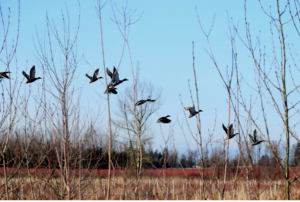Hunting for waterfowl is an amazing and pleasurable experience. Waterfowl hunting is appropriate for the entire family. Children as young as five can start to get involved. However, depending on your experience with hunting, getting started may seem like a daunting task.

Yet, if the novice hunter plans accordingly and thinks carefully about each step, they can be on their way to safely and effectively hunt waterfowl in no time. But getting started is no simple task and getting prematurely involved is not a good idea, it could even be dangerous.
So, exactly how hard is it to get started with waterfowl hunting? Read these major points of consideration and tips to find out.
Firearm Skills
By its very nature, waterfowl hunting requires the use of firearms. Specifically, the shotgun. The shotgun is perhaps the easiest firearm to wield, making waterfowl hunting one of the most accessible forms of sport hunting available to the beginner. However, it’s not advisable to just pick up a gun and get started.
It’s recommended that every novice hunter completes a firearm safety program, commonly known as a hunter’s safety course. It’s likely that this course is even required by your state government to obtain a hunting license. Once you get your hunter’s safety card and tag permit, you are well on your way to going out and getting some goose and duck meat. Your family will have a newfound respect for you when they see you bringing home dinner like a pioneer.
And even after completing a gun safety program, the novice hunter needs to practice wielding the firearm. This can be done in various places depending on where you live. The safest and best option is to go to a shooting range. You may even be able to hire an instructor for a few lessons to help you get started. Other options for people located in more rural areas include going out and firing at targets against an old riverbank. Whatever you do, make sure there is nobody downrange from you whenever you start practicing your shotgun skills.
Permits And Licenses
To get a hunting license, the novice hunter needs to take their hunter’s safety card and form of ID down to a fishing and game office. After filling out a form, providing the required documents, and paying the fee, you will be issued your hunting license. This license is required to stay with the hunter at all times when hunting. If the game warden finds you, and you are without your hunting permit, you will be fine. You could even be arrested.
With a hunter’s safety card and hunting license in hand, you’re ready to get your game tags, also known as your hunting permit. These are obtained at the same office as your hunting license. And you’ll get it as soon as you receive your hunting license. For most kinds of games, a hunter needs to obtain a permit or tag for each animal they intend to kill. Other times, a hunting license is enough.
If you do not require a game tag to hunt waterfowl in your region, there is likely a bag limit. A bag limit is a limitation put on the hunter to prevent them from taking too many birds in a single day. A bag limit may be as little as one and as high as five birds per day. This bag limit is determined by the wildlife conservation department and is intended to keep waterfowl populations at a healthy level.
Ground Technique
After mastering the basics, it’s time to get down and dirty. This means your ground technique. There are many different ways to hunt waterfowl. And you may want to look into the different techniques available. Some people prefer to hide in the marsh and wait in the early mornings for the ducks to take flight as the sun rises. And others prefer to hunt from a boat. Hunting from a boat means waiting in reeds on the water until your flock of ducks or geese decides to take off for the morning.
To Dog Or Not To Dog
Mini duck and geese hunters prefer to use well-trained hunting dogs to assist them in their endeavor. Having a hunting dog can greatly improve the outcome of your hunting experience. This is because waterfowl are often shot over marshlands or lakes. A properly trained hunting dog can immediately run and retrieve your kill before it sinks to the bottom of the river or washes downstream. Hunting dogs can also flush out hidden prey while you stay calm and collected, lying and wait.
 If you’re looking to get into hunting, waterfowl sport is a great way to get started. The required choice of firearm is the easiest to use of all the options available. Hunting requires permits, licenses, and firearm certifications, so be sure to look into the requirements for your locality. When all of that is done, the fun stuff begins. Refine your ground technique and consider training a hunting dog. Do all this, and you’ll be well on your way to hunting mastery.
If you’re looking to get into hunting, waterfowl sport is a great way to get started. The required choice of firearm is the easiest to use of all the options available. Hunting requires permits, licenses, and firearm certifications, so be sure to look into the requirements for your locality. When all of that is done, the fun stuff begins. Refine your ground technique and consider training a hunting dog. Do all this, and you’ll be well on your way to hunting mastery.

